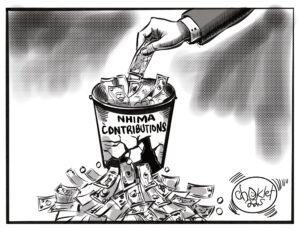As we approach the end of 2024, and with only two weeks remaining before the 2025 national budget is presented, it is an opportune moment to reflect on the performance of the 2024 budget. Presented under the theme “Unlocking Economic Potential,” the 2024 budget aimed to tackle critical challenges and promote growth across key sectors such as mining, agriculture, energy, and manufacturing. But with three quarters of the year behind us, the question remains on how much progress has the country made in meeting the objectives of the 2024 national budget. This opinion piece will focus on assessing government expenditure, revenue collection, and the performance of key sectors during the first half of 2024.
Expenditure Performance
The budget allocated K177.9 billion for government spending, focusing on infrastructure development, social services, and economic projects. By mid-year, total expenditure stood at K88.76 billion, slightly below the projected K89.77 billion, as per the 2024 Mid-Year Budget Performance Report which was published by the National Assembly of Zambia. Delays in the implementation of several capital projects, particularly in infrastructure development, were cited as the primary reason for the underperformance. Additionally, lower-than-expected revenue contributed to the reduced expenditure.
Revenue Performance
Regarding revenue, the 2024 budget projected total revenue and grants of K177.9 billion, with expectations for increased tax collection, stronger mining royalties, and greater domestic resource mobilization. By mid-year, total revenue and grants amounted to K74.77 billion, just below the targeted K75.8 billion. This shortfall was mainly due to reduced production in the mining sector and lower copper prices, which impacted mining royalties and taxes. Non-tax revenues, including contributions from tourism and services, showed positive trends but were insufficient to offset the shortfall in mining-related revenues.
Sectoral Performance
The performance of key sectors, including mining, agriculture, and energy, also fell below expectations. The mining sector, a backbone of the economy, continued to face operational inefficiencies, declining ore grades at major mining sites and limited investments. Copper production for the first half of 2024 reached 336,090 metric tonnes, but this wasn’t enough to meet revenue targets. The combination of lower output and reduced global copper prices weakened government revenues from mining royalties and taxes.
In the agriculture sector, Zambia experienced a significant impact from drought during the 2023-2024 farming season. This was considered one of the worst droughts the country has faced in recent memory. According to the Ministry of Agriculture, the country recorded a net deficit of 2,107,745 metric tonnes of maize, compared to an expected production of 3.2 million metric tonnes. The shortfall in maize production affected food security for approximately 1.5 million people and reduced Zambia’s ability to meet both domestic and export demands. The underperformance of the agriculture sector highlights its vulnerability to climate-related risks and underscores the need for investment in more resilient farming practices.
The energy sector also struggled in 2024, as Zambia relies on hydropower for 85 percent of its electricity generation. Low water levels in the Kariba Dam, due to the drought, has significantly reduced hydropower generation capacity. This resulted in widespread load shedding, with some areas experiencing power outages lasting for days. These energy shortages had a serious impact on industrial productivity, particularly for SMEs, many of which reported lower output levels and increased operational costs due to reliance on backup power sources.
Elsewhere, the Stanbic Bank Zambia Purchasing Managers’ Index (PMI), which measures private sector activity, showed a contraction throughout most of 2024. The average PMI from January to August was 48.5, below the 50.0 mark, signalling reduced business activity. By August, the PMI had dropped to 48.3, marking the ninth consecutive month of contraction. Factors contributing to the decline included reduced new orders, persistent load shedding, and rising input costs, which made it difficult for manufacturers to maintain productivity.
On the public debt front, the government successfully reached an agreement with Eurobond holders, leading to the launch of the consent solicitation and bond exchange in June 2024. This agreement requires the immediate resumption of debt service payments on “Bond A,” with US$341 million projected for servicing this year. Combined with last year’s agreement with official bilateral creditors, this brings the total restructured debt to 77% of the required scope, while negotiations with the remaining private creditors are ongoing and unlikely to conclude by the end of this year.
Conclusion
The implementation of Zambia’s 2024 national budget has been marked by significant challenges across key sectors. Revenue collection fell short of expectations, largely due to the underperformance of the mining sector. Meanwhile, the agriculture sector was heavily impacted by drought, while the energy sector has continued to struggle with reduced hydropower output, leading to widespread load shedding. These issues have significantly hindered Zambia’s economic progress in 2024.
As the 2025 national budget approaches, it is essential to address these structural issues and implement strategies that will promote sustainable growth and unlock Zambia’s full economic potential. Join me next week as I explore expectations for the 2025 budget and the steps needed to overcome the obstacles that have hindered progress in 2024.
About the Author
Isaac Mwaipopo Heads the Centre for Trade Policy and Development in Zambia, providing guidance on trade policies, public finance, extractives, and legislative reviews. His extensive experience ensures the organization remains a key resource for developments in these areas.
























